25+ Statistics About Data-Driven Recruiting From the Greenhouse OPEN Conference

In 2019, we attended the Greenhouse OPEN conference, where 1,000 Greenhouse clients and talent acquisition professionals spent two days talking about strategy, tactics, and the rapidly changing landscape of the talent acquisition ecosystem.
We were particularly interested in the topics and themes focused on data-driven recruitment to learn how some of the best companies in the world think about using data to make their recruiting process more efficient, predictable, and successful. We took copious notes during the sessions, and below are some of the takeaways from the event.

Industry Benchmarks
Katie Josephson from Thrive Capital hosted a session to share talent metrics from a recent benchmark report across their portfolio of high-growth startups, which are distributed evenly across Seed through Series D+ and a wide range of industries like B2C, FinTech, Enterprise SaaS, and healthcare. Here are some key statistics.
Company Culture and Heath
- Company NPS: great companies have scores in the 70s, and high scores have significant implications for a successful hiring process.
- Attrition: it’s common to see attrition increase as companies grow. Average attrition rates: early-stage at 10%, mid-stage at 15%, and late-stage at 18%.
- You should measure diversity and inclusion metrics across the company and the department. Accountability ultimately sits with the CEO and executive team.
Top Level Recruiting Metrics
- Offer acceptance rates: vary widely, but best-in-class is 85%. She’s also seen as low as 30%. Key factors: hiring manager closing ability, compensation market alignment, running an efficient recruiting process.
- Candidate Experience: 80% positive is the goal. Accountability should be shared across the entire recruiting team, including hiring managers.
- Cost-per-hire: $10k per hire, although very difficult when tracking data across organizations.
- Time-to-fill: varies by role. Executives can take 3-6 months and sometimes as high as 9-12 months. Other roles can range from 6-to 10 weeks. Higher for tech roles, lower for more junior positions.
- Onsite-to-offer: 4 onsite visits to one offer; some companies as low as 2:1. If much higher, it could indicate a hiring manager decision-making issue or requirement misalignment between the hiring manager and recruiter.
- Recruiter quarterly hiring targets: 8-12 business hires, 4-6 technology hires. They noticed an upward trend with technology efficiency gains.
- Team ratios: 3 Recruiters : 1 Sourcer : 1 Coordinator
The key to measuring against the benchmarks is having a well-defined internal scorecard that becomes more robust as the business grows and the right processes to capture accurate data.
Applying Data to Your Recruiting Process
Shane Noe from Box and Nick Reylan from Squarespace walked through their respective approaches to creating a data-driven recruiting process. They agreed there are three key things to focus on as a base for becoming a data-driven hiring organization:
- Data is only as good as it is accurate. For example, time-in-stage — make sure the team updates on time and doesn’t get muddied with other factors.
- Data is only valuable if people have access to it. If recruiting isn’t sharing data, it feels like a black hole to the rest of the company. Make sure your hiring team (executives, hiring managers, sourcers, coordinators) has access to the data in consumable and understandable formats.
- Data is only half the story. It just signals where to focus your optimization efforts.
For both Shane and Nick, it starts with a recruiter capacity model. Shane walked through his approach, which includes the following:
- Start by looking historically by quarter to understand how a Full-Time Equivalent (FTE) was spent with each functional group (Sales and Marketing, Tech and Product, and G&A). For example, if you had one resource spending half their time between Sales and Product, they would be assigned 50% FTE resource to each.
- Then, look at how many hires were made quarterly across each functional group.
- Multiply the number of hires by the allocated FTE to get your hiring capacity by functional area.
- Roll the capacity forward to get a sense of future ability. Cross-reference with financial and board-level hiring goals to ensure coverage for future hiring plans. Add a 15-25% buffer in capacity to factor in recruiting teams turnover and unforeseen issues.

Once a recruiting capacity forecast is established, leverage recruitment data to optimize the steps in the entire recruitment process. Some key points:
- Make sure you keep recruiting stages simple and consistent across roles. Remove steps where there are no pass-through rates (i.e., conversion rates), as it may not provide actionable insight.
- Understand how recruiter time is allocated across end-to-end hiring stages, from sourcing to offer. Recruiter.com research shows that more than 60% of recruiting time is spent on sourcing activities. Applying an AI solution at this stage could significantly increase the overall productivity of the recruiting organization.
- Mid-stage analytics need to be reviewed in the proper context. There are a lot of variables that drive performance, including hiring managers, recruiting process speed, interview requirements per role, etc.
- Pay attention to crucial conversion rates and choose only 1 to 3 areas to optimize at a given time. For example, offer acceptance rate: is below 60%, you’re not selling enough. Work with the hiring manager to redesign why working at the company is the right move. It may require multiple revisions to move the needle. Get in a cycle of test, learn, optimize.
Where Does AI Fit in the Recruiting Process?
Moving from planning to tactics, various panelists shared that while they believe Artificial Intelligence can be valuable to their entire hiring process, it was tough to decipher what is real versus smoke and mirrors. A point that came across was that out of the ten things a recruiter has to do all day, the one thing AI does better than humans is source qualified candidates.
One speaker made a point of reference to how AI has benefited other tasks where individual selections are made from thousands or millions of choices. You can see this in action with Netflix movie recommendations and Spotify’s Discover Weekly Playlists in the consumer world. When using these services, the user saves tremendous amounts of time reviewing a personalized set of movie and music choices instead of guessing what to search. The AI models ultimately find highly relevant media the user wouldn’t otherwise discover.
The same approach applies to sourcing. Instead of requiring a recruiter to think of all relevant keywords and search candidates one by one, AI models can take job requirements and analyze millions of recruiting data points to return candidates. Like Spotify Discover Weekly, it will produce highly relevant candidates the recruiter wouldn’t otherwise find.
We regularly see AI having the following impact with Recruiter.com AI sourcing software clients:
- Recruiters can reduce their time looking for potential candidates by up to 80%.
- AI can return 2-3x more relevant candidates for a search.
- Hiring manager screening pass-through rates (i.e., conversion rates) improve as hiring managers to provide feedback to the AI model.
Email: The Recruiting Workhorse
Despite many calls for the death of email, it still chugs along as the most effective communication channel for consumers and businesses. eCommerce sites drive up to 40% of their revenue through email. The average person checks their email 15 times per day or every 37 minutes.
Key high-level stats about email and recruiting:
- 79.2% of candidates prefer email over other communication channels.
- 40% of tech talent have their LinkedIn InMail alerts turned off as they prefer standard email.
- The average office worker receives 121 emails per day, so relevance is vital.
- Personalization can have a huge impact, increasing reply rates by over 2x.
When creating personalization, there are three levels to consider. Just remember, each group of personalization increases the positive reply rate. It’s essential to analyze time versus conversion for each level. More junior roles lend themselves to less personalization, but if you’re trying to recruit a data scientist out of a pool of only 50 people, 1:1 is the way. Three levels:
- Bulk Messaging: using the same content for all candidates.
- Bulk Personalized: creating tailored content for a targeted segment. For example, engineers from financial service backgrounds would receive content relevant to their specific industry and its relation to the open role. (The Recruiter.com AI targeting engine makes this segmentation very easy to execute.)
- Individualized Messages: Take time to write 1:1 messages for each candidate. It will drive the highest conversion rate and require the biggest time commitment.
Another excellent capability of email is the ability to test various campaign components to improve overall performance. Key testing areas include:
- Open rates: if your recruiting email rates are less than 50%, focus on testing different approaches to subject lines.
- Sender: Recruiter.com clients see a significant lift in reply rates when a message comes from a hiring manager or executive. This is an easy test to run because it doesn’t require additional content.
- Content: This is where recruiters tend to spend the most time. Unfortunately, there is no magic bullet. The problem is when someone discusses an approach that works for them at a conference like the Greenhouse Open, 500 people will try that same approach, reducing the uniqueness and impact of the message. Areas to test: short vs. long, highlighting the benefits of the role and company, different calls to action, etc. Don’t be afraid to try other things. You never know what will resonate with the candidates!
- Day of Week and Time of Day: The day of the week and timing are highly unpredictable. We recommend testing for what works best for your company. Start with a common-sense approach to timing. Earlier in the week is better. By the end of the week, people are looking forward to the weekend. Try to send during times when candidates are not busy. Early in the morning, around lunchtime, and evenings. Also, test weekends, when people are not buried with work.
We see the combination of AI candidate sourcing and email testing as a vast opportunity to improve the efficiency and success of the sourcing process. This is why we built the Recruiter.com platform to have AI sourcing and email testing/sending fully integrated. The data from each step drives the performance of the other step, and a fully integrated solution will deliver the best results.
It’s An Exciting Time in Talent Acquisition
The Greenhouse team put on another fantastic event, and we were excited to see data-driven recruiting as one of the key themes throughout the client sessions. We’re only in the first inning.
As a company focused on helping hiring teams leverage data and AI to execute more successfully, we look forward to working with organizations to help them achieve their recruiting goals.
To learn more about how Recruiter.com can help you, check out our recruiting solutions or contact us today to get more information on which strategy is best for your company.
Get the top recruiting news and insights delivered to your inbox every week. Sign up for the Recruiter Today newsletter.
